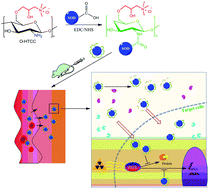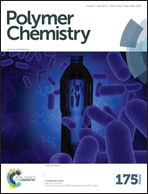The conjugation of Cu/Zn superoxide dismutase (SOD) to O-(2-hydroxyl) propyl-3-trimethyl ammonium chitosan chloride (O-HTCC) enhances its therapeutic potential against radiation-induced oxidative damage†
Abstract
A novel polymer–enzyme conjugate, O-HTCC–SOD, was prepared through the conjugation of Cu/Zn superoxide dismutase (SOD) to a macromolecular carrier, O-(2-hydroxyl)propyl-3-trimethyl ammonium chitosan chloride (O-HTCC), by the carbodiimide-mediated coupling method. The resulting O-HTCC–SOD conjugate was characterized by various analytical methods. It was a positively charged polymer with broader molecular weight distribution. Circular dichroism (CD) spectra revealed that the conjugated O-HTCC increased highly ordered secondary motifs of SOD, but also reduced partial β-sheet conformation that is crucial for enzymatic activity, which led to a ∼19% activity loss. O-HTCC–SOD could increase its catalytic activity to a maximum of 2.3-fold through gradual cleavage of O-HTCC linked to SOD by α-amylase. It exhibited low cytotoxicity to cells, and superior membrane permeability to native SOD. The conjugate, alone or incubated with α-amylase, significantly protected cell viability from ionizing radiation-induced oxidative damage by scavenging intracellular reactive oxygen species (ROS). Pharmacokinetic analysis demonstrated that the conjugation of O-HTCC to SOD prolonged its half-life 8.2-fold and increased its bioavailability to 1.56-fold after a single intravenous administration compared to native SOD, and that the time to maximum serum concentration (Tmax) of O-HTCC–SOD was 50-fold longer than that of native SOD, suggesting unique sustained activity enhancement in vivo presumably triggered by biodegradability of O-HTCC. We finally investigated its therapeutic effect against ROS-induced damage induced by whole-body X-ray radiation in mice. O-HTCC–SOD remarkably attenuated ROS-induced oxidative damage and induced tissue protection in mice whereas native SOD failed to do so. Therefore, the biodegradable cationic chitosan derivative O-HTCC can serve as a carrier to improve the therapeutic potential of SOD. The O-HTCC–SOD conjugate might be a promising therapeutic agent for treatment of ROS-related diseases.


 Please wait while we load your content...
Please wait while we load your content...